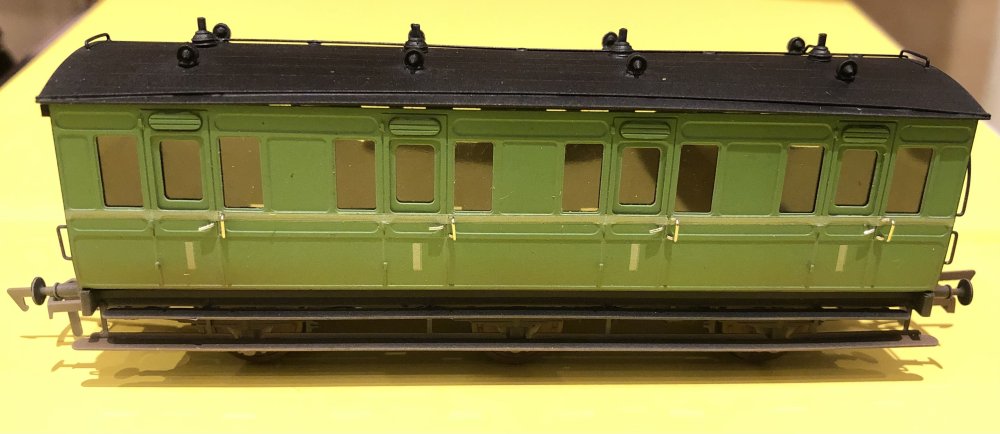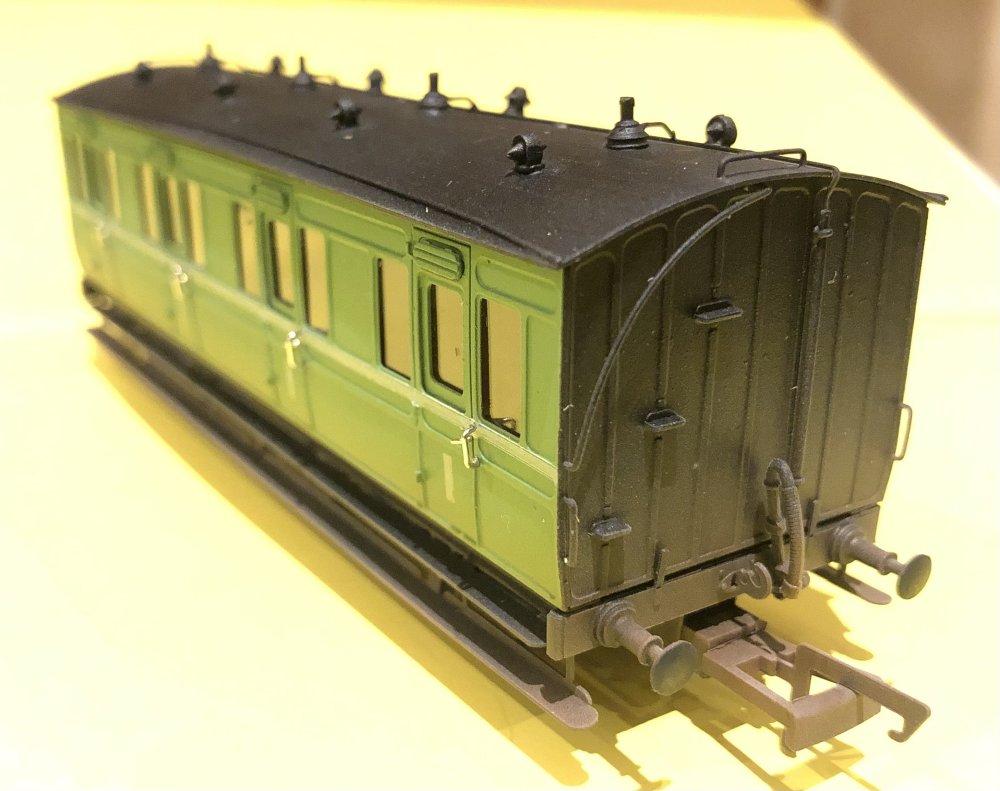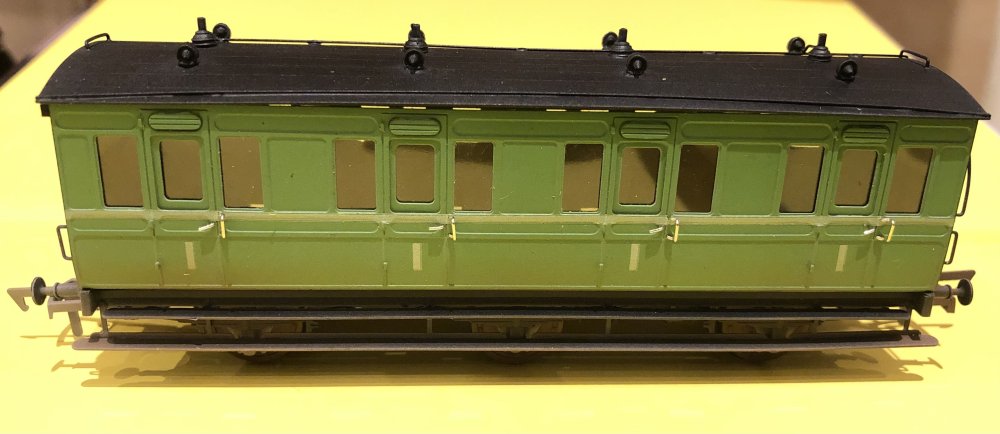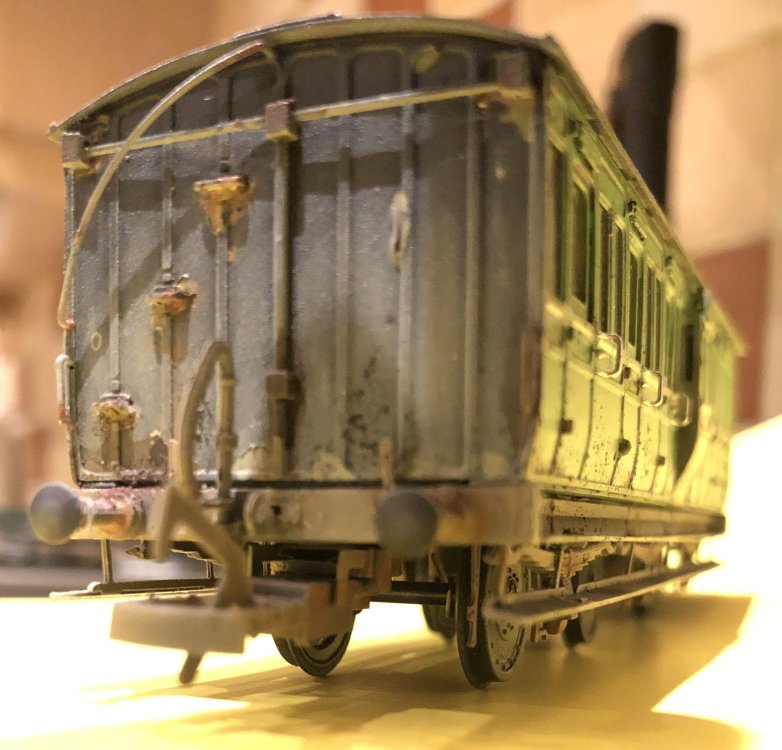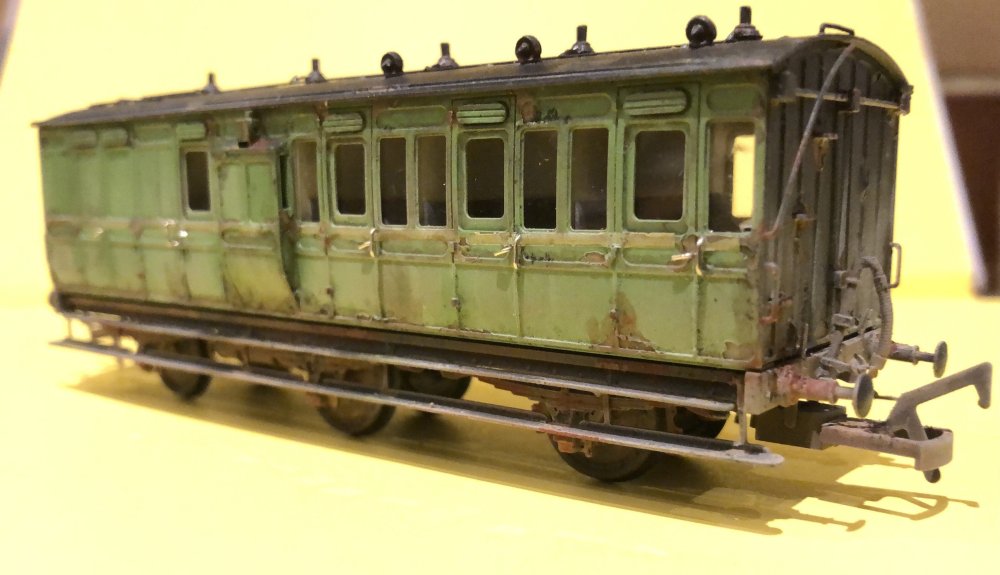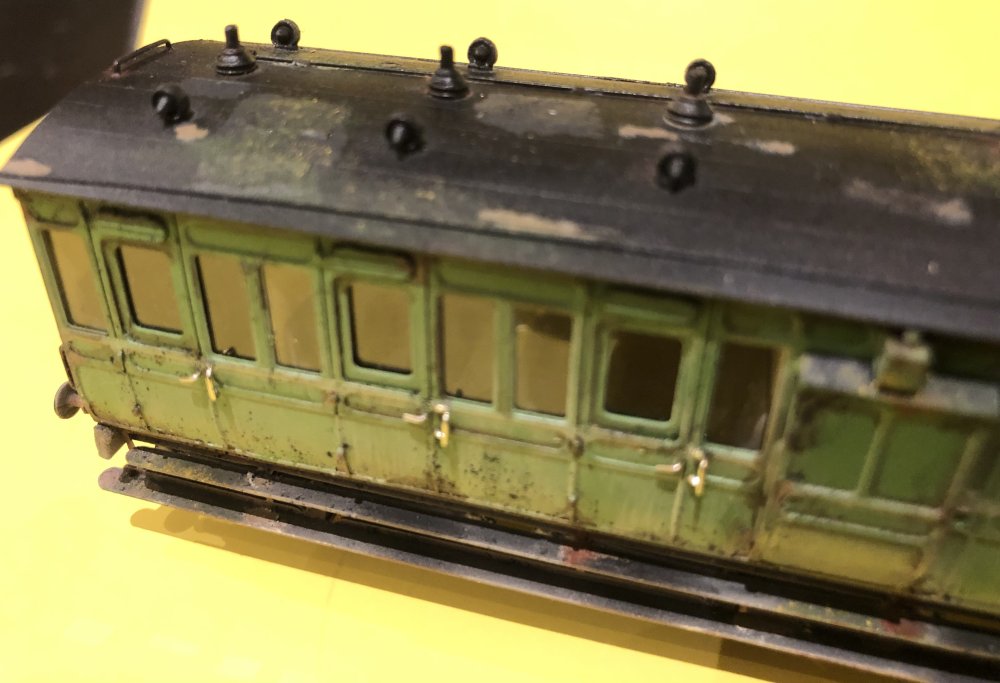-
Posts
15,860 -
Joined
-
Last visited
-
Days Won
393
Content Type
Profiles
Forums
Events
Gallery
Everything posted by jhb171achill
-
For Kilfree Junction, while it was obviously on the MGWR, and while GSWR or GNR locos would have been absent, ex-GSWR carriages turned up from time to time. At the very end, the branch set was an ex-GSWR six wheel passenger brake, and either a Bredin compo or a GSWR composite wooden-bodied bogie. You can thus make an authentic branch mixed train with the following: SSM GSWR 6-wheel passenger brake third or full brake. (Failing that, the forthcoming Hattons ready-to-run 6-wheel full brake is a pretty close approximation to some GSWR coach types) SSM Bredin composite SSM CIE brakevan kit for the end of mixed trains Various wagons of either IRM, Provincial Wagons or SSM origin; namely (a) the IRM flats, Bullied opens and H vans; (essential) the Provincial cattle wagons, as cattle was the only busy traffic that branch ever had; JM design GSR open wagons; and SSM MGWR convertible vans and open wagons. On the main line side, a Murphy 121 or 141, and unless RTR laminates appear, the forthcoming IRM Park Royals, mixed with SSM Bredins, and essentially a "tin van" - for which the only current option is a pretty basic example from Silverfox; and beware, as the silver and green options are invariably in an inexcusably wrong version of the livery. If you're in steam times, obviously carriages will be green, as the orange and black only appeared a matter of months before all steam ended. The good news here is that the Ballaghaderreen branch seems to be the only place where any coach newly turned out in orange and black was ever steam hauled - this was an old GSWR six-wheel full brake, for a matter of weeks before that line closed.
-
J15s wouldn't have been used on the Midland - instead, their own equivalents, the J18s. The J15s were seen always as "southern engines", and while they invaded the DSER soon after 1925 and would remain there to the end of steam, they rarely if ever ventured anywhere on trhe MGWR - never on most lines - and never darkened the corridors of Wisht Caark either. As you say, the "E" class tank is suitable - and in terms of an MGWR branch line, actually the only authentic option currently available. A RTR Midland engine is something that as in preservation in real life, is sorely lacking. Oooooh boy, I remember that! Painful!
-
He even has a model of a very well-known member of this forum leaning out of the window of a Craven, if I remember rightly! (And this post brings it onto page 72!)
-
Irish Railway News ‘Enterprise Watch’
jhb171achill replied to IrishTrainScenes's topic in General Chat
During this week, what is De Deitrich and what is railcars? Planning to go north to have a last spin to Gt Vic St - but I'm not going in a railcar! -
The roundel appeared in 1963. Immediately prior to that, stencilled snails. Brown later, from 1970, so obviously brown always has roundels.
-
Very definitely. I’ve seen pictures of them in Enniskillen, Omagh & Clones.
-
The SLNCR went down a black hole east of Glenfarne...... (don't tell Galteemore)..........
-
Correct. The UTA had no diesel locos and steam engines were few after they got rid of goods in 1965. This went on into NIR times. The last remaining steam locos were entirely occupied with shunting York Road and the spoil trains, so none were available for goods trains. The MPD railcars had been designed by the UTA with the same sort of rationale as the CDRJC: railcars capable of hauling goods - hence "MPD" = "Multi-purpose diesel". So, a CIE loco - my principal memories are entirely of 141s in the 60s - took the train north, and two or three MPD cars would haul the Derry traffic up the NCC. The advent of the Hunslets initially made no difference, though once the 111s appeared, Hunslets were to be seen on this duty. Images even exist of (exceptionally rare) double-headed Hunslets on the Derry goods. CIE locos, of course, also made it into Waterside station.
-
Your weathering skills are picture-photo-perfect accuracy!
-
VERY much so. As these were being churned out en masse in Inchicore, the UTA was doing its best to run down rail freight in the north, eventually withdrawing it in 1965 - but not before their dwindling fleet of badly neglected wagons were falling to pieces, so CIE ones were necessary. Add to that the fact that the vast bulk of what goods traffic was left, consisted of Dublin / Dundalk to Foyle Road or Grosvenor Road. Thus, from the division of the GNR between CIE & the UTA - AND before it - "southern" wagons were always to be seen, but now would become more commonplace. After 1965, obviouswly, ALL wagons were CIE, and since the vast bulk of gioods was in vans, this meant that "H" vans - plus some older CIE / GSR types - comprised 100% of van traffic. I regularly saw the goods trains in those days on the ex-GNR route. I remember seeing the first "roundel" logos appearing in trains otherwise bedecked in stencilled flying snails, and hauled by those new black'n'tan 141 thingys. The O'Dea photo there shows a fitted train hauled by sveral MPD railcars, but before that even, CIE-owned wagons were commonplace. The same may be said of Bullied Opens. Between Provincial Leslie's GNR goods vans, and the new IRM products (opens included, and flats), you've everything you need to recreate a 1960s goods train, bar a CIE 20T or 30T brake van. For that, there's a Studio Scale Models kit - or possibly if JM Design still has some? The old GNR guard's vans were more used on UTA ballast trains. Since the goods trains came from Dundalk, standard CIE vans would be used. Can't say it never happened, but I never saw an ex-GNR guard's van on an actual goods train by that stage. (And if you DO get one, Provincial Wagons have one - but fer gawd's sakes dont paint the black ironwork on it and cream balcony that "Ivan" has at Whitehead; nothing ever ran like that....!). In the 1960s, of course, all wagons were grey; the brown would start to appear after 1970. While cattle was still being carried on the system elsewhere, as far as I'm aware, the last time you'd have seen cattle trucks in a Dundalk - Belfast train was probably in the mid-1950s, so no need for cattle wagons. I certainly never saw any on that route - and I don't have any recollection of seeing grain wagons either. A typical train had 30-35 four wheels wagons and a brake van. (I used to count 'em). In the mid-60s, the cement bubbles started appearing. They were standard wagon grey, like everything else. The IRM model has a black chassis, uniquely for the time, though I never remember ever seeing o0ne in this guise - only plain grey all over as normal. However, photographic evidence of both exists, which leads me to conclude that one batch was all grey, and other had black on it for some reason. By about 1968 they were starting to paint them orange - grey 9not black) chassis. And then you started getting fitted container wagons. The very earliest were grey, but they were entering traiif around the same time the brown livery was starting to appear. I remember seeing the odd (loose-coupled) flat in the trai9n, usually with a baler or a new car on it, probably from Ford's in Cork. Of the thirty-odd wagons on each train, at least twenty would be goods vans, and by about 1966 you would have amongst this maybe one GSR horizontal-planked van, three or four "Palvans" and the rest "H"'s. Now, we know what this means; purchase of many H vans will be necessary! As for the Derry Road, the make-up of a train was very much similar, though it closed before all of the ex-GNR vans were scrapped. Thus, the only difference to the above might be a few badly neglected looking ex-GNR vans with UTA markings over their increasingly scruffy appearance, in with the CIE vans. Another thing which was to be seen on Derry Road goods trains was an occasional CIE (passenger!) "tin van" carrying newspapers. I stand to be corrected on this, but I am unaware of cement wagons ever appearing on that line - they were only being built then anyway. On the Belfast services, I stand to be corrected again, but I'm sure I saw some "back to backs" on that too.
-
Yorkgate closes, York Street opens
jhb171achill replied to Darrman's topic in What's happening on the network?
Three things irritate me intensely about Translinksterbus. 1. Every single location is called "----- Train Station"; from major stations like Lanyon Centralplace Maysfields, or whatever it's called this month, to Lambeg halt. 2. Yet Dundalk is called a "Rail halt", yet places like Scarva or Bellarena, mere platforms in the wilderness, are "train stations". 3. The massively irritating middle-England BBC accent on all the station announcements. What's wrong with an accent from somewhere within the NIR network? -
That would be an ecumenical matter.
-
Saw that - most interesting that anything like this existed at all, let alone lasted into GSR days! A coach number in the GSR’s 900 series (933) will indeed be of WLWR origin; in the case of a vehicle like this, probably W & L.
-
Did that myself, yes. I recall being in a venerable GNR bogie in CIE / UTA days, and the seat by the window was damp. The roof was leaking above it, and drip-dripping down, as it started raining into the journey. Myself and two others had to move. Also, I recall a strong damp musty smell, alive with the spores of damp rot, in a compartment in an ex-NCC "North Atlantic" coach in the late 1960s. The exterior was clean though, with paint almost still wet after being repainted from UTA green to the short-lived NIR "main line steam stock" all-over maroon.
-
Now that's a good use indeed!
-
Seems strange in our modern affluent age - if a carriage in that state turned up on the 15:35 to Tralee today, Joe Duffy’s phone lines would be jammed by the outraged in their BMWs in the station car park. But such things were commonplace at one time. Look at any picture of, say, probably the worst examples - the Cavan & Leitrim in CIE days, or the SLNCR, or some UTA stock in the late 60s, and you’ll see carriages that look practically derelict - and, I can attest from my own memory, weren’t any better inside! I’ve a set of 4 of these GSWR ones. I had suggested to Eoin to make the brake look a whole lot worse than the others, which appear well-kept and only slightly work-stained. The idea here is prototypical; these old brake coaches often inhabited the same rural branch service for several years, with visits to Limerick or Inchicore for painting being less frequent than the “passenger” stock.
-
True, but my point was - if you look at the body design & panelling, and wheelbase. The Ratio-type, used by a number of British railway companies, used the same type of “modern” body type & profile as main line bogies. I’ve an idea some even had toilets. Four wheelers here in design terms belonged to an earlier era, with body design similar to 1870s. Also, wheelbases for four-wheelers were a lot shorter. The Ratio type, in having a much longer wheelbase, plus 1880s onwards body design, are thus not at all like anything 4-wheeled we ever had - they look more like our 6-wheelers. Most Irish railways used a standard length of 30ft for 6-wheelers. The Ratio yokes are about 26ft, by the look of them. As you say, the curved-in ends, commonplace among a number of British companies (MR & GWR particularly) were unknown in Ireland with the exception of some on the WLWR, so on that third basis the Ratio kit is immediately “un-Irish”. As an aside, those Hornby clerestorey roofed bogies bear a good resemblance, due to their curved ends, to several WLWR prototypes, provided the clerestorey is removed and replaced by a “flat” roof. The brake third is especially suitable, as apart from having an extra compartment it is very similar to a pair of WLWR brake thirds which lasted until 1954 & 1955.
-
Hattons had been considering this, and had asked me to supply livery details along with “nearest equivalent” suitable carriage numbers, immediately before the news broke of their demise. I had actually sent them details of the later GSR maroon (easy, as it was the same as LMS), and the earlier very dark chocolatey-crimson shade. Six wheelers are not known to ever have carried the short-lived “main line” chocolate & cream livery, nor did the GSWR put cream upper panels on them. Pity it wasn’t to be.
-
Eoin Murray’s SSM ones unveiled tonight on Dugort Harbour thread. It will be interesting to see them alongside a shiny IRM silver Park Royal, or indeed compared with the Hattons ones.
-
The Dugort Harbour branch has had a set of four GSWR six-wheelers allocated to it lately. The all-1st, a compo and a third are in pretty good condition given their age, but the old 1888 brake third badly needs a repaint and tidy up. It’ll meet with its end once these new laminates are all built, but they’re due in summer 1959, so we’ve almost eighteen months of this thing….. Received from Eoin Murray today; as always, truly outstanding master build of SSM kits. Note the realistic canvas roof patches on the brake, faded paint and general weathering with brake dust.
-
Indeed - too short, and Ireland never had 4-wheelers of that type of English long wheelbase style. But €5 each and a slap of green paint can’t be sneezed at!
-
Clogherhead - A GNR(I) Seaside Terminus
jhb171achill replied to Patrick Davey's topic in Irish Model Layouts
The site of the sheds at Howth are now occupied by one of the most utterly hideous apartment developments I have ever seen in this country. More appropriate to Communist Russia in the 1950s than anything here. Ghastly looking things; hopefully they will find pyrite in them in 18 months and knock them all down again and build something somewhat pleasing on the eye. -
Clogherhead - A GNR(I) Seaside Terminus
jhb171achill replied to Patrick Davey's topic in Irish Model Layouts
Very good thinking, indeed! And up to 1960, anythi9ng from GNR tank engines and anciuent wooden stock to Gardner articulated railcars onj passenger - plus the tram! Was at the museum the other day with a friend and we were lamenting the fact that if only the section from Howth up to the summit had survived, what an attraction today! -
Clogherhead - A GNR(I) Seaside Terminus
jhb171achill replied to Patrick Davey's topic in Irish Model Layouts
Diesel fumes and sea air; a 1975 Howth station smell….. but Guinness was 28p a pint…… -
Pity we haven’t a good model of an Irish horse box - none of the available British designs are even remotely close to ours….
.png.c363cdf5c3fb7955cd92a55eb6dbbae0.png)






